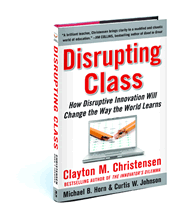Today I presented my workshop entitled: Personalized Education requires Digital Identity. I was fortunate enough to have a nice group of people listening to my presentation and actively participating by asking good questions often comparing the solutions Kennisnet implemented in the Netherlands (i.e. Entree and Edurep) with the situation in the USA. My presentation is on slideshare for download, including my speaking notes. I inserted the sheets below.
The abstract of my presentation in the program reads as follows:
Personalized education aims to offer a student an individual curriculum, developing each person’s unique talents and interests. Today, in our rapidly digitizing education, we increasingly use digital learning materials in electronic learning environments, student administration systems and testing & assessment software. Students and teachers increasingly learn and work ‘anytime/anyplace’ interacting with these systems. To realize a custom education path for each student these systems need to be able to react to the students use of learning materials, (change of) study plans, their test results, etc. The systems need to ‘know’ who the student is. The only alternative to this is someone feeding these systems by hand with a lesson programs per student per day…
But how do we enable systems to service an individual student, implementing a learner centered education? These systems need to know what students like (learning style), what their talents are, which weak spots they have, which earlier courses they took, what part of the test they made mistakes in, etc. etc. This set of assertions about a person comprises (part of) his/her identity. Being able to take this information into account our education software systems can do the bulk of the work, enabling teachers to use dashboard like interfaces to tweak the student programs and incorporate their own observations as professional educators to provide the student with his/her individual optimal learning experience.
In this presentation we will talk about this concept and offer a few practical considerations when working towards an integrated digital learning environment. We will also look into the more social aspects of identity, both in real life and digital.
The moderator for my workshop was Michael Porter, CTO @ Traverse Bay Area Intermediate School District, Traverse City, MI. It was a privilege working with Mike these last few days during the conference, lets stay in touch Mike!
Observations about innovation strategies in Education
Besides speaking at the conference I also listened to a number of very interesting presentations and workshops. Almost everyone is talking about the need for change in the education system in their particular country.
 One wonders what the best strategy would be for innovating current education. Change is clearly needed, but should it be evolutionary or disruptive? Listening to three great speakers at the CoSN 2010 conference a clear answer to that question emerges. Opening Keynote speaker Larry Keeley argued that organizations intent on innovation should focus on non-users/non-customers, those are the ones you need to convince. Charlie Leadbeater argues that the best environment for innovation is where things are bad, the need for change is evident there. Curtis Johnson, co-author of ‘Disrupting Class’, argues that the only successful innovation within existing companies occurs in separate environments, given the latitude for radical change. The direction of these arguments is clear: innovate education in places where results are very poor, separate that environment from current practice and give the initiative full autonomy!
One wonders what the best strategy would be for innovating current education. Change is clearly needed, but should it be evolutionary or disruptive? Listening to three great speakers at the CoSN 2010 conference a clear answer to that question emerges. Opening Keynote speaker Larry Keeley argued that organizations intent on innovation should focus on non-users/non-customers, those are the ones you need to convince. Charlie Leadbeater argues that the best environment for innovation is where things are bad, the need for change is evident there. Curtis Johnson, co-author of ‘Disrupting Class’, argues that the only successful innovation within existing companies occurs in separate environments, given the latitude for radical change. The direction of these arguments is clear: innovate education in places where results are very poor, separate that environment from current practice and give the initiative full autonomy!
Mike (March/2010)
 2021
2021